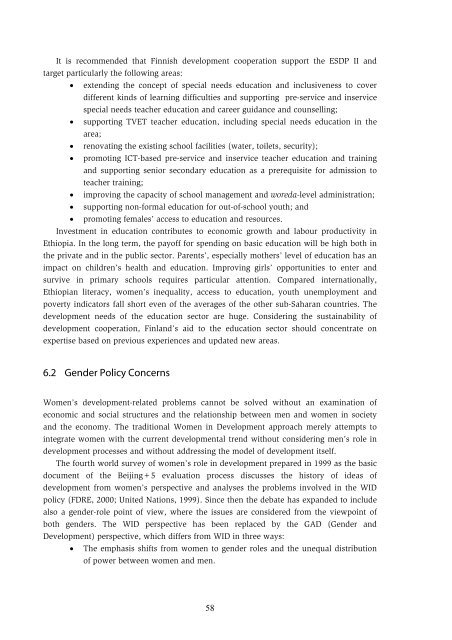Education and Training in Ethiopia An Evaluation of Approaching EFA Goals
Education and Training in Ethiopia - Koulutuksen tutkimuslaitos
Education and Training in Ethiopia - Koulutuksen tutkimuslaitos
- No tags were found...
Create successful ePaper yourself
Turn your PDF publications into a flip-book with our unique Google optimized e-Paper software.
It is recommended that F<strong>in</strong>nish development cooperation support the ESDP II <strong>and</strong>target particularly the follow<strong>in</strong>g areas:• extend<strong>in</strong>g the concept <strong>of</strong> special needs education <strong>and</strong> <strong>in</strong>clusiveness to coverdifferent k<strong>in</strong>ds <strong>of</strong> learn<strong>in</strong>g difficulties <strong>and</strong> support<strong>in</strong>g pre-service <strong>and</strong> <strong>in</strong>servicespecial needs teacher education <strong>and</strong> career guidance <strong>and</strong> counsell<strong>in</strong>g;• support<strong>in</strong>g TVET teacher education, <strong>in</strong>clud<strong>in</strong>g special needs education <strong>in</strong> thearea;• renovat<strong>in</strong>g the exist<strong>in</strong>g school facilities (water, toilets, security);• promot<strong>in</strong>g ICT-based pre-service <strong>and</strong> <strong>in</strong>service teacher education <strong>and</strong> tra<strong>in</strong><strong>in</strong>g<strong>and</strong> support<strong>in</strong>g senior secondary education as a prerequisite for admission toteacher tra<strong>in</strong><strong>in</strong>g;• improv<strong>in</strong>g the capacity <strong>of</strong> school management <strong>and</strong> woreda-level adm<strong>in</strong>istration;• support<strong>in</strong>g non-formal education for out-<strong>of</strong>-school youth; <strong>and</strong>• promot<strong>in</strong>g females’ access to education <strong>and</strong> resources.Investment <strong>in</strong> education contributes to economic growth <strong>and</strong> labour productivity <strong>in</strong><strong>Ethiopia</strong>. In the long term, the pay<strong>of</strong>f for spend<strong>in</strong>g on basic education will be high both <strong>in</strong>the private <strong>and</strong> <strong>in</strong> the public sector. Parents’, especially mothers’ level <strong>of</strong> education has animpact on children’s health <strong>and</strong> education. Improv<strong>in</strong>g girls’ opportunities to enter <strong>and</strong>survive <strong>in</strong> primary schools requires particular attention. Compared <strong>in</strong>ternationally,<strong>Ethiopia</strong>n literacy, women’s <strong>in</strong>equality, access to education, youth unemployment <strong>and</strong>poverty <strong>in</strong>dicators fall short even <strong>of</strong> the averages <strong>of</strong> the other sub-Saharan countries. Thedevelopment needs <strong>of</strong> the education sector are huge. Consider<strong>in</strong>g the susta<strong>in</strong>ability <strong>of</strong>development cooperation, F<strong>in</strong>l<strong>and</strong>’s aid to the education sector should concentrate onexpertise based on previous experiences <strong>and</strong> updated new areas.6.2 Gender Policy ConcernsWomen’s development-related problems cannot be solved without an exam<strong>in</strong>ation <strong>of</strong>economic <strong>and</strong> social structures <strong>and</strong> the relationship between men <strong>and</strong> women <strong>in</strong> society<strong>and</strong> the economy. The traditional Women <strong>in</strong> Development approach merely attempts to<strong>in</strong>tegrate women with the current developmental trend without consider<strong>in</strong>g men’s role <strong>in</strong>development processes <strong>and</strong> without address<strong>in</strong>g the model <strong>of</strong> development itself.The fourth world survey <strong>of</strong> women’s role <strong>in</strong> development prepared <strong>in</strong> 1999 as the basicdocument <strong>of</strong> the Beij<strong>in</strong>g+5 evaluation process discusses the history <strong>of</strong> ideas <strong>of</strong>development from women’s perspective <strong>and</strong> analyses the problems <strong>in</strong>volved <strong>in</strong> the WIDpolicy (FDRE, 2000; United Nations, 1999). S<strong>in</strong>ce then the debate has exp<strong>and</strong>ed to <strong>in</strong>cludealso a gender-role po<strong>in</strong>t <strong>of</strong> view, where the issues are considered from the viewpo<strong>in</strong>t <strong>of</strong>both genders. The WID perspective has been replaced by the GAD (Gender <strong>and</strong>Development) perspective, which differs from WID <strong>in</strong> three ways:• The emphasis shifts from women to gender roles <strong>and</strong> the unequal distribution<strong>of</strong> power between women <strong>and</strong> men.58




![to read the full report [pdf, Amharic] - Ethiopian Review](https://img.yumpu.com/52737829/1/190x245/to-read-the-full-report-pdf-amharic-ethiopian-review.jpg?quality=85)











